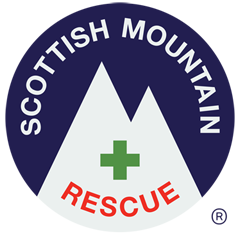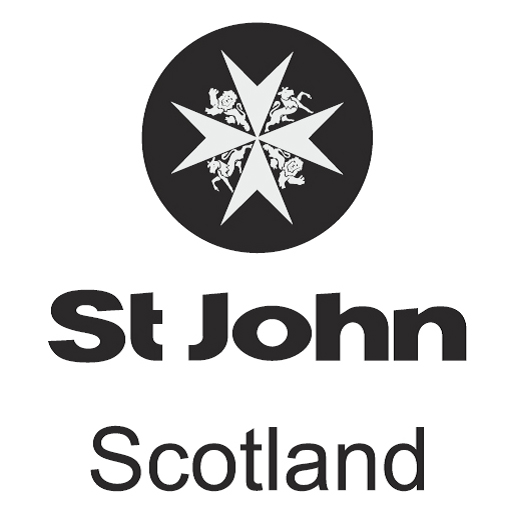In the early hours of 14 March, 1951, an RAF Lancaster bomber, TX264, was returning to Kinloss, from a training flight, when it crashed just below the top of the Triple Buttress of Coire Mhic Fhearchair, on Beinn Eighe. Aircraft wreckage can still be seen in “Fuselage Gully” and in the corrie below. Five months were required to retrieve all the bodies and it was apparent that special skills were required for mountain rescue in such locations. The RAF Mountain Rescue Team was born.
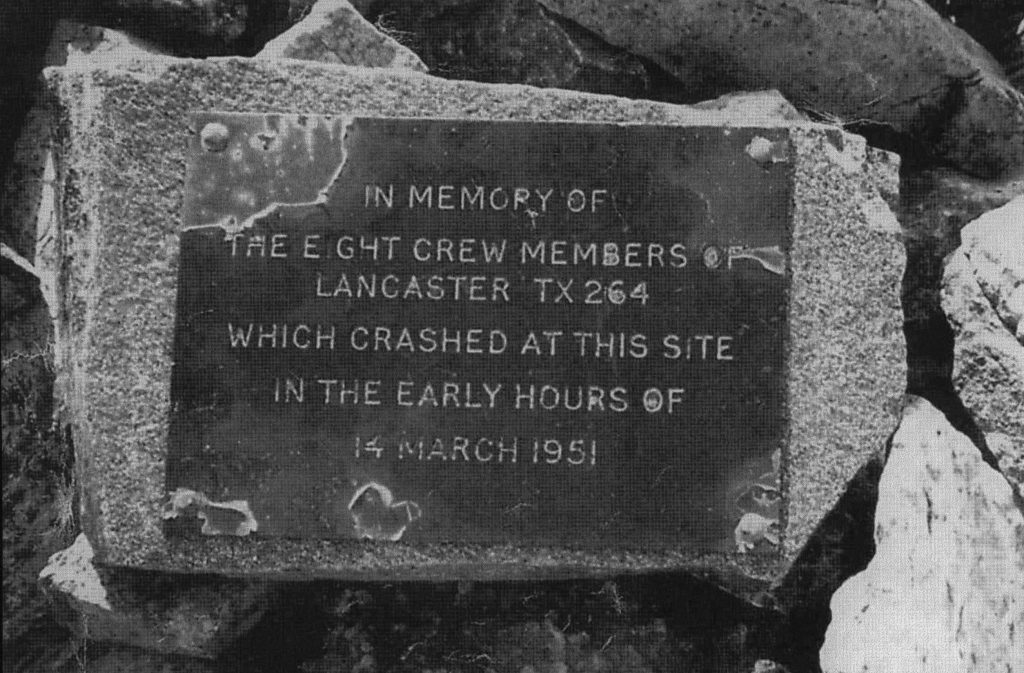
The two photographs below were taken by, Joss Gosling, the last surviving member of the original rescue team. The first shows four of the rescue team on the snow and ice in the middle of Loch Coire Mhic Fhearchair, reflecting the severity of the 1950-’51 winter. The second picture is of the Triple Buttress. “Fuselage Gully” lies to the right of the right hand buttress.
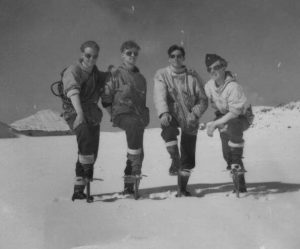
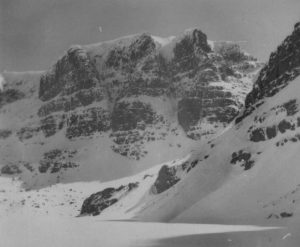
Team member, Ryan MacLean, with the wreath placed in the corrie on the 60th anniversary of the crash.
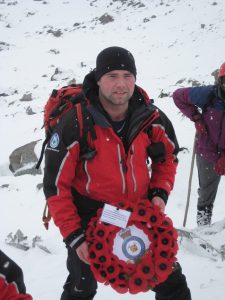
Joss Gosling, on the right, with “Heavy” Walley, for many years leader of the RAF Mountain Rescue Team.
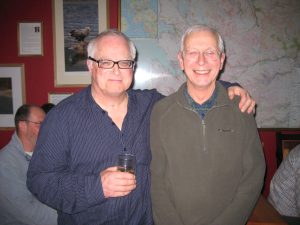
It would be some years before civilian mountain rescue teams were established in Scotland. When Charlie Rose, the first leader of the Torridon MRT, came to live in Alligin, in 1966, he found that rescues were “organised on an ad hoc basis”. Volunteers were rounded up and deployed under the direction of the local Police officer. It was only after the tragic deaths, on Cairngorm, of five Edinburgh schoolchildren and a student teacher, in November, 1971, that the Scottish Office recognised the need for a network of rescue teams. Charlie Rose’s account of his time as team leader is below, along with those of his successors. Charlie died in February, 2015 – his obituary, in the Scottish Mountaineering Journal, is also below.
There have been 6 leaders of the Team so far (December, 2016). The first 5 all have contributed recollections, below, of their time in office. An edited version of their pieces was include in the Scottish Mountaineering Club Journal for 2016.
CHARLIE ROSE, TEAM LEADER 1972 – 1987
Charlie at home in September 2014.
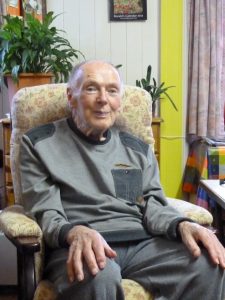
When I first came to live in Alligin, in Easter 1966, Anancaun (Field Station for the Beinn Eighe National Nature Reserve) was the designated MR Post for the area. In those days rescues were organised on an ad hoc basis with Dick Balharry, the then Reserve Warden, assembling local volunteers at the behest of the Police. Usually Sergeant Donnie Smith would appear to take over actual team leadership for the duration of the rescue. Rescues on the core area mountains were often based on the Glen Cottage (at that time run as a back-packing hostel by Dave & Liz Goulder).
Following the Feith Buidhe Disaster in November, 1971, Hamish MacInnes was consulted by the Scottish Office and in liaison with affected Police authorities, proposed the setting up of additional volunteer civilian mountain rescue teams in areas palpably not yet covered. Hamish asked me if I could raise a team in this area; the incentive was that the Police Budget would cover equipping and maintaining the team and we would become a part of the overall network with all the attendant benefits (access to training courses and seminars, helicopter assistance, etc).
At about the time the team was being formed, the Scottish Youth Hostels Association built a new modern hostel in Torridon and immediately agreed it should be designated the new MR Post for the area, and that the team might use it as its headquarters. Neil Reilleay, the first warden and his wife Irene, became enthusiastic helpers providing storage and accommodation for the team equipment and rooms for meetings, etc. Whenever a call-out occurred they would stay up all night if necessary providing hot drinks, a phone link, and unflagging support. All subsequent wardens and their wives have been equally supportive and played a major role in the efficient functioning of the team. A further incalculable bonus to the team has been that we have always been able to recruit able bodied, and often experienced, helpers from the hostellers staying at the time.
Initially, the team was composed primarily of local crofters, stalkers and foresters from the surrounding sporting estates as well as the personnel of the Beinn Eighe nature reserve together with some older stalwarts who, while no longer able to go on the hill, did sterling work manning the base radio and providing a courier link between it and the nearest telephone – frequently an all-night vigil. There were relatively few team members who had previous sport-mountaineering experience but the outstanding strength most could bring to any rescue was their intimate knowledge of the local hills and their fitness; they knew the best route to take under any conditions and were undeterred by the vilest weather.
In addition, the team benefited from the wholehearted co-operation of our local general practitioner. Over the years the incumbent has changed several times but all have been universally supportive, coming on the hill when the occasion permitted, running first-aid courses and always on hand to field casualties the moment they were brought off the hill.
In the early days facilities were limited. We had few radios and helicopters were scarce. I vividly recall one search situation where the Wessex we had been allocated successfully terminated the operation by flying low over widely scattered groups of searchers with the winchman sitting in the open door displaying a large piece of cardboard with “GO HOME” written on it!
Over time steady progress was made. Police liaison improved, courses were held at Glenmore Lodge in first aid and dog handling. Exercises were held with RAF MR Kinloss and with Helicopter Wing, Lossiemouth. Improvements in basic equipment, especially in numbers and performance of walkie-talkies and the allocation of a MR Band together with the introduction of Sea Kings gradually altered the entire MR scene and speeded up reaction times.
Compared with some other teams we had a very sleepy wee corner of the Highlands. For many years we averaged about four full-scale rescues a year with perhaps twice as many alarms which did not, in the end, necessitate calling the whole team out. However, in the seventeen or so years I was the team leader we encountered a dozen fatalities, many broken limbs and assorted injuries and many lost individuals, together with the usual crop of bizarre incidents – individuals or even groups of people who inexplicably ‘vanished’ from their companions wandering round the back of Beinn Alligin, Beinn Dearg, or Beinn Eighe because they had been busy blethering, didn’t have a map, or had caught sight of Loch Maree in the distance and thought it must be Loch Torridon! I sometimes wondered whether we weren’t in the business of rescuing mountains from the more zany behaviour of the human race. At the end of it all, however, the real reward comes with the elation we all feel when we have succeeded in rescuing someone who was in serious trouble and we can say, “Yes, it WAS worthwhile”. And I wonder if anyone ever spares a thought for our wives and families who have to spend days and nights worrying about us in the most appalling weather?
OBITUARY IN THE SMC JOURNAL 2015
CHARLES STUART ROSE
Charlie Rose was one of the first people I met on joining the EUMC, way back about 1947 and he is about the last survivor of my generation. He did all the student things – climbed on Salisbury Crags on Sunday mornings, got ritually chased by the park-keepers. One Sunday we all got trapped and had to give our names; it was quite a haul for the keepers; they got the names of half a dozen Professors from various faculties.
Charlie was a good all round mountaineer with an amazing physique. He took part in the ritual ascent of the castle rock on Charities Day and in the ascent of the Scott Monument when a large flag was furled from the topmost pinnacle. The offending flag was removed by council workers before 9 a.m. the next morning. It involved the erection of scaffolding and was a creditable, indeed superior effort on their part.
After graduating from the Art College he went to seek his fortune in London, working for Unilever as an Art Buyer. More importantly he forged a parallel career in the Territorial Army becoming a Captain in the parachute regiment. He very casually mentioned some of his weekend exploits. One I remember was a night drop in Denmark with a heavy kitbag of equipment dangling on a rope from his harness; the kitbag hit the ground first and slowed up the descent. He was back at his desk on the Monday morning.
In 1958 he was a member of the Scottish East Greenland Expedition and made some first ascents in the Stauning Alps including the crossing of the Col Major. He subsequently made two climbing trips to Nepal.
He returned to Scotland in1966 to a house with a view in Alligin where he and Priscilla raised a family. He did various jobs there and at one stage worked on a local fish farm, owned ironically by Unilever. He and Priscilla became dedicated members of the local community. He kept up his climbing in Scotland and for a time was leader of the local Mountain Rescue Team. He had his small boat on the beach below his house; the dream that so many have but seldom achieve.
His house in Alligin was always welcoming and conversations with Charlie were always wide-ranging and not short of opinions. Few of his friends in the Club are left to mourn his passing.
Iain Smart
Peter Biggar writes: as long as people keep climbing at Diabaig Charlie Rose’s name will live on because, most unusually nowadays, an area of cliff, Charlie’s Dome, and a climb on the Main Wall, Charlie’s Tower (60m HS 4b) are named after him. The latter route and Gamhnachain’s Crack (75m HVS) on the Main Cliff were climbed with the redoubtable Allan Austin and R Valentine in 1976. The 1970s were a good time for Charlie in climbing terms for in ’71 and ’72 he discovered the climbing potential of Coire Rudha-Staca on Beinn Eighe and pioneered five routes including Thin Man’s Ridge (HS), the delightfully named Independent Pineapple (S) and Spog aig Giomach (S). His companions were Ronald Turnbull and David Howard. Midge Ridge (V Diff) was climbed with S Peterson.
Charlie was a good friend of the late Dick Balharry and both of them delighted in telling the tale of how they dragged the elderly Lord Howick Head of the Nature Conservancy up the Cioch in Applecross. This gentleman suffered from some complaint which meant he had to have frequent rests and they didn’t get back to Kinlochewe Hotel until very late: whereupon his lordship woke everyone up to applaud his achievement.
Charlie was our neighbour and friend in Torridon for some 35 years. Always a fascinating conversationalist, he spoke the purest English of anyone I can remember and never changed the way he spoke. He liked his hot drinks hot and his cold drinks cold. You never came to Heathercliff without receiving warm hospitality. Charlie Rose was a real gentleman.
TERRY DOE, TEAM LEADER 1987 – 1994
Terry in the 1970’s
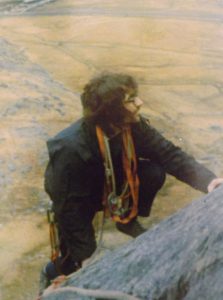
One evening in 1977 I knocked on the door of Charlie Rose’s house in Alligin, introduced myself and said that I was interested in joining the Torridon and Kinlochewe Mountain Rescue Team. He looked surprised and asked “why would anyone want to get involved with mountain rescue?” I replied something like “you did” and went on to explain that I was an active mountaineer and that I had spent the previous four years working as a full-time mountaineering instructor at an outdoor centre in Applecross. I was now employed as a deer-stalker / manager on a local sporting estate and that I would shortly be moving into Balgy Lodge, across the loch from his house.
I was now in the Team and very shortly, presumably because of my background and experience I was appointed Deputy Team Leader. The Team members were mostly locals, many of them were shepherds or deer-stalkers working and living on the local estates. They were very strong and competent on the hill with a wealth of local knowledge which proved invaluable on many occasions.
Call-outs at that time consisted mainly of searches and recoveries with the occasional need to set up anchors to lower the stretcher off steep ground. Many of the jobs were over-nighters involving hours of stretcher carrying only made easier by attaching the wheel when we eventually reached the path. Helicopters did not fly at night but would endeavour to pick us up soon after first light. We had no radio communication with the aircraft so resorted to using flares and hand-signals from the winchman hanging out the side door. One day whilst involved in extricating a crag-bound walker from high up on the south side of Liathach a very large, highly polished, bright yellow RAF helicopter arrived on scene and went onto complete the job. This was our first sight of a Sea King helicopter and the first time it had ever been used in a mountain rescue situation in Scotland.
In 1987 I moved to Kinlochewe. On occasions over the previous ten years Charlie had asked me if I would step up to become Team Leader, only now did I feel settled enough to take on the role. I was excited by the challenge because I realised that the Torridon MR Team had to modernise in order to cope with the increase in the numbers of people visiting the local hills and going out in hostile weather conditions due to the improvements in outdoor clothing and equipment.
I identified areas where the Team needed to make changes. These were:
Team Management
A general meeting was called and officers elected. The Team Leader acted as chairman and secretary. Officers elected were: Deputy Team Leader, Treasurer, Training Officer, Medical Officer and Equipment Officer. These general meetings were to be held annually. A priority was to gain charitable status which we did.
Team Base
We were grateful to The Scottish Youth Hostel Association who allowed us to use a store cupboard in the hostel. They gave us permission to upgrade the store and equip it with shelves and hanging racks with a separate area where we eventually installed a telephone and our base radio. The Youth hostel was an official mountain rescue post, I later gained permission to designate Anancaun SNH Field Station, in Kinlochewe, an official mountain rescue post, which gave us access to all the kit required to equip it for free. An unofficial post was established at Craig next door to Chris Mackenzie’s house.
Team Equipment
The Team equipment was very old, out-dated and needed to be replaced. We had been issued a new base radio and a couple of hand-held but we required more hand-held. I approached the Howard Doris Trust who stumped-up £936 to purchase three radios which were located one at each MR post. This meant an advanced unit carrying first-aid could be on its way to the casualty before the bulk of the Team arrived. We purchased climbing ropes, pre-stretched ropes, new stretchers, “cas- bags” and much, much more. I approached Sprayway who gave a 50% discount on their Gore-Tex Torridon mountain jacket and over trousers. We purchased fifteen sets and were able to help Sprayway with their advertising. A donation from Boots Across Scotland charity went a long way toward covering the cost of purchasing the new equipment required, plus donations received from grateful rescued and bereaved families. One lady left the Team £15,700 in her will; ironically we had recovered her body from Moruisg, Glen Carron. In 1992 we took delivery of our first Team vehicle, a 4×4 Ford Transit donated to us by British Telecom. The rear of the vehicle was filled with kit and fitted with a base radio which meant we had a mobile base; a massive leap forward and a great asset.
Team Training
The Team needed to train regularly. I put this statement to the Team at an AGM. I proposed the Team should meet monthly, the first Sunday in every month. Most members agreed to Team training but some were worried about training on Sunday, the Sabbath. I suggested that training would not be compulsory and that each team member should look to his own conscience. Initially I took control of the monthly training, concentrating on personal MR skills required for both summer and winter conditions. Navigation, safe movement over steep ground, use of ice-axe and crampons etc. Later crag rescue skills were covered and the correct use of technical kit involved in stretcher lowering and hauling. Team members were encouraged to attend external MR courses at Glenmore Lodge and Shell Seminars.
Medical Training
The Team was fortunate to have as our Medical Officer, Dr Andrew Brown our local GP. Andrew was also a Surgeon Commander in the Royal Navy Reserve and was well qualified to instruct us on trauma injuries. He undertook to train us during our monthly training sessions on mountain first-aid and made himself available during the de-brief of recent incidents involving injuries. For the very keen first-aiders he also ran weekly evening sessions at his home which gave us the chance to pick his brains on matters that might be worrying us. I tried to ensure that there was a first-aid component in every monthly training session, usually involving packaging the casualty and loading him on the stretcher in ever more awkward situations.
During a conversation with an old friend now working as a ski patroller I asked where did the ski patrol go for its medical training and could he supply me with contact details. Months later five naïve Team members headed south in the new Team vehicle to the North Staffordshire Royal Infirmary, Stoke-on-Trent, for a five day Emergency Medical Technician Course. There then followed one of the most intensive, stressful, five days of medical training any of us had ever undertook, culminating in an easily failable examination. We all passed and were very grateful to return to Torridon. By the time we were due for re-validation the British Association of Ski Patrols had set up their own Emergency Medical Technician (EMT) courses. The courses were held much closer to home and were based entirely on mountain rescue situations so we attended these in the future. The EMT’s became the front-line in casualty management and generally took control of the casualty on the hill, but it was still very important for the other team members to keep their first-aid skills up to date and were encouraged to do so.
Helicopters
Helicopters were soon recognised as an extremely useful asset in mountain rescue. Initially during a rescue the Team had no radio communication with the helicopter until the winchman was landed on scene, later if possible we would loan the crew one of our hand-held radios, even later the crew would arrive on scene with their own hand held mountain rescue radio. After time of course we were able to speak to them directly when they were able to change their radio frequency to ours. RAF helicopters were not allowed to winch our mountain rescue stretcher; which meant waiting for the aircrew to lower their stretcher or to transfer the casualty from our stretcher to theirs. Medics working on a casualty were sometimes hassled to prepare the casualty for winching before he was stabilised and it took a lot of courage to tell the aircraft to go away until it was called in. Sometimes the helicopter would go straight to the scene of the incident and double strop the casualty without apparent concern for the individual’s injuries. These were all matters that needed to be resolved and is where the Mountain Rescue Committee of Scotland (now renamed Mountain Rescue Scotland) stepped in to convey the Team’s concerns to the RAF.
The Team in the Community
The Team involved itself with the local community by providing safety cover for charitable sponsored walks including; Highland Hospice, Lochcarron Heritage Museum, Highland Cross. We used these events as a valuable radio communication training session. We also gave the local children an annual rock climbing and abseiling day at Ardheslaig Crag which proved very popular and supplied us with a couple of future Team members.
Summary
The period between 1987 and 1994 was a very busy time for the Torridon MRT. There was so much to do to modernise the way the Team was managed and equipped, and to prepare it for the challenges of the future. I was so grateful for the support I received from the Team members and cannot thank them enough for the commitment and effort that has filtered right through to the present time where the Team of the future has been built upon the solid foundations we created together.
Footnote
During the period 1977 to 1987 two years went by without a single call-out. In 1993 the Torridon MRT attended 13 incidents, four of them involving fatalities.
Terry also wrote the following about the stresses associated with mountain rescue.
Scotland’s Mountains Can Be Dangerous.
Every mountainous area has a team of unpaid volunteers who undertake to assist and rescue members of the public getting into difficulties on the local mountains. The team members are not necessarily mountaineers or climbers, some are just fit folk willing to assist people having problems.
I have been a member of our local mountain rescue team for more than 30 years, I am a mountaineer and an active rock climber. My jobs within the team have included Team Leader, Training Officer and now Team medic.
Team Leader
The Team Leader role is similar to a military commander during battle. He has to send his team members, who are also his friends, into situations of extreme danger. Although part of a Team, The job of Team Leader it is also one of the loneliest.
The telephone rings, usually during the night or when just settling down after a hard day at work. It is the police passing on a message concerning injured or lost persons out on the hill. The transition from normality to high stress is instant and action must follow.
A very cold winter’s night in February. Every star in the sky is visible the moon is bright. Every breath is felt and the extremities freeze in minutes. We fly over a moonlit landscape, below us and in the distance the hills are on fire. Giant flames licking up into the sky as the tinder dry heather and grass burn fiercely, a beautiful site but evidence of mans carelessness and disregard for his own environment. I guide the helicopter to the looming rock-face ahead. The massive vertical rockface is punctuated by small, snow covered ledges and frightening ice choked cracks and fissures. The powerful spotlight of the aircraft scans the verticality. Suddenly, there below us is the injured climber waving desperately to attract our attention, 150 m up a 300m rockface with life-threatening injuries to his right femur. His situation is desperate.
The call is mine. I am the team leader. What to do? We must land on the mountain ridge above the climber, myself and two others. Crampons on boots, ice-axes in hand we prepare to be lowered to the ridge. The helicopter approaches the narrow ridge covered in hard-packed snow, ice glistens in the light of the moon. I am prepared. I want to do this. Suddenly the aircraft veers away and we head out into clear sky. There is no wind, the helicopter cannot hover.
Back at base I am greeted by my team members. They look at me for action. What is my plan? What will they be required to do? For years I had dreaded this very moment. This rescue was my worst nightmare. My guys are good, very good, but I was feeling very frightened for them on this one. Looking at them and knowing them so well, could I really ask them to do this? I had no choice. I must be careful how I choose the front-line guys. The ones who would be lowered to the casualty and evacuate him from his hell. The climber was dying, but he was tough, one of Scotland’s finest. The fact that I knew him didn’t help.
The climber was rescued safely. He was very badly injured and lucky to be alive. Looking at my boys as they returned to the mountain rescue base I recognised the thousand yard stare in their eyes and knew that some of them had been to hell and back that night.
Team Medic
My job is now team medic. This can be a very lonely job. Usually the first to be called, my job is to get ahead of the other troops, reach the casualty, stabilise him and await evacuation. Walking, almost running up the hill, day or night, the mind is full of detail. What will I find? Can I get to him? Do I have the right medical equipment?
A horrible day in November. Low mist on the mountains, rain and snow showers. Eating my lunch at work. My manager puts his head around the door. “Rescue, man fallen into gully, you are needed, helicopter on its way.”
This is not a good day for the hill, but they seldom are. The Royal Navy helicopter puts six of us down on the mountain ridge just below the cloud. We head for the mountain top on foot and begin a descent into a large open coire, looking for the gully and the fallen walker. My pal thinks he hears a shout. Above us is a narrow, chimney like fissure and the shout appears to be coming from there. I tie onto one end of a 50m rope and my friend ties into the other end. I begin to climb; on my back is a heavy pack with medical kit and oxygen. This climb is not difficult but dangerous. The rock is loose, worn smooth by water and there are no placements for safeguarding my progress. This is no place for negative thoughts, although I do know that if I fall my friend would be pulled down with me. I was climbing a subsidiary gully that led out above a larger gully diving 200m to the scree below us. Finally I put my head up and see a figure lying in amongst a jumble of rocks, he sees me and waves frantically. I find a ledge and bring my friend up to me on the rope. I leave him to deal with the casualty, he is a very good medic, whilst I start setting up rope anchors for the rest of the team to ascend the gully.
The situation was extremely dangerous. The man had fallen and slid to the bottom of a fan-shaped stricture at the top of a vertical gully plunging 200m to the scree below. Every rock that fell from above funnelled into this stricture and had the potential of knocking us off the gully floor. We had to stabilise the casualty and lower him down the gully and for this we needed more men. Gradually three more team members arrived by climbing up the rope I had fixed. At last we were in a position to lower the casualty on the stretcher that one of the guys had brought up. I was a little away from the medical action supervising the stretcher lower when I noticed a lot of action at the casualty, and my friend saying, “no don’t do this, not now” The casualty had died.
What did I think?
The casualty had fought for his life. I was sad and disappointed but he wasn’t alone when he died. He had been terrified until we arrived and had been sliding down the smooth rock until he was overlooking the precipice below him. He was entirely helpless.
When I first arrived at the site of the accident I was being very careful. By the time I eventually abseiled the 200m to the gully bottom and relative safety, I didn’t care about what might have happened to me. I knew that I would be very lucky to get out of this situation without getting hit by falling rocks. I thought I was going to die here in this gully. I didn’t care. I was someone who wasn’t there. I was a spectator looking at my own body executing tasks it had done on many previous occasions.
Twelve hours after the initial call I crawled into my bed.
SEAMUS MACNALLY, TEAM LEADER 1994 – 2000
Terry Doe stepped down as Team Leader in February 1994 and after a brief three years as a member I was voted into this role. At that time there was still a good number of local members and support for the team was excellent. Bill Taylor was treasurer, and Cam Macleay became training officer, with Nick McNeil and Tom Forrest as deputies. Throughout the six years other office bearers included Dickie Livingstone, Chris MacKenzie, Mike Dunlop and Neil Hinchliff.
Quite early on I decided the office bearers should meet on a regular basis and this started the cycle the team now have of committee meetings almost on a monthly basis. This shared the burden of decision making and also kept the whole process democratic and open. Team members were always welcome to attend meetings too and discuss whatever was on the agenda. Money was never plentiful and at one stage the contents of our current account was perilously close to zero, but we were not alone among teams in that situation, especially on the west coast and further north.
At this time I was also a member of the local Coastguard team and was starting to train as a search and rescue dog handler so life was never dull and being around other rescue organisations allowed a good insight into the world of rescue and the politics of the whole business.
One aspect not mentioned often enough is the support team members receive from their families because without it the structure would soon break down. A certain amount of guilt still exists over the number of week-ends when I was at meetings or training and therefore not around for the family. In that first year as leader, the number of events attended related to mountain rescue was more than 70 (training, administration, call outs, giving talks, and SARDA).
Rescues in those days often involved long stretcher carries with casualties, usually at night and in wintry conditions. The helicopters, both RAF and Coastguard, were good but we as a team had to work hard on numerous occasions when they were unable to offer support. There is however, no better way of bonding folk together, than long hours on the hill under arduous conditions, when all the training kicks in and the outcome is successful.
Fatalities were, and still are unfortunately, not uncommon and this brought another side to mountain rescue which is dealing with the survivors and the friends and family of the deceased. The Police are good at dealing with the necessary officialdom, whereas the team are good at handling the nearest and dearest and absorbing the sadness of the moment.
After these events the leader often has to deal with correspondence from friends and family. One particular incident involved two young winter climbers who were avalanched due to a cornice collapse at the top of their route. One died at the scene and his companion was found stuck in the snow with various injuries. Both were stretchered from the back of Liathach in the dark, down to the roadside to a waiting ambulance. The mother of the young man who died wrote to the team thanking them for their assistance and asking about the circumstances of the accident. Thus began a correspondence lasting a couple of years, which only ended when the lady eventually managed to visit Torridon, and with a companion, walk in to the corrie where her son had fallen. This, thankfully, gave her some peace of mind and closure of a kind.
The team continues to thrive and adapt to changing situations, and it was a privilege to have had the title of Team Leader for a few years. After two terms in post I felt someone else should have the chance to take over, as I am not a believer in the same person taking on such a role for decades. Fresh ways are good, although having the chance to continue as a deputy with the next two leaders, hopefully meant the wheel was not re-invented too often, while allowing new ideas to come to the fore.
NEIL HINCHLIFF, TEAM LEADER 2000 – 2010
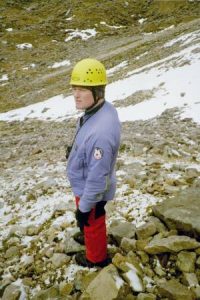
When I joined the team in 1994, Seamus (MacNally) was leader. Seamus was an extremely fit and capable guy living right next door to the team base, and together with his search and rescue dog, Max, fulfilled this role perfectly. However, prior to the AGM in Feb 2000, Seamus decided he would be stepping down as team leader…so then, and following much badgering from both Seamus and Goretex Mike, I was pushed into the spotlight, and as there were no other takers for the post at the meeting, I was suddenly “it”.
Other than fitness, dedication, and the ability to work as a team, it is prudent to always be aware of the strengths and weaknesses of those on a rescue with you…however, it was now crucial for me to also know absolutely everything about each individual team member. This would clearly include their skills within mountain rescue, but also other attributes; eg, who knows a particular area backwards; the order they would arrive at base; who is capable of carrying specific, large, heavy items of kit up the hill. And then there were the purely personal and perhaps even private characteristics that you had to be up-to-date with eg, who didn’t really like the thought of flying; who wasn’t so happy on exposed terrain; who was dating who. All these factors, plus dozens more, were always crucial to ensuring that we, the team, executed the rescue as swiftly, safely, and professionally as possible, for the benefit of the person in difficulty.
Since moving away from the Torridon area, I have been attached to Skye MRT, and the Hebrides SAR, (and before Torridon, Killin MRT), and whilst each team may have a totally different terrain to cover, the enthusiasm is omni-present.
I can also recall many times when individual team members’ lives have been literally “on the line”, as rescues evolved, and in hindsight, I would love to see these achievements recognized formally.
Over the 10 years as team leader, I cannot praise those involved within the team enough: nor can I offer enough thanks to their families and work colleagues for their understanding when a “shout” is announced.
Regarding the recent announcement of a new team base being erected this year…this event hasn’t come soon enough. Even in the early “noughties” this proposed new base was considered essential, in order to help concentrate all the professional attributes of the team into one purpose-made spot. The effects of this will inevitably help even further to ensure that anyone requiring rescuing in Torridon’s mountains will receive maximum assistance.
EOGHAIN MACLEAN, TEAM LEADER 2010 – 2013
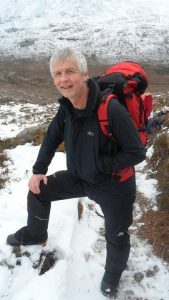
I joined Mountain Rescue as a very young 18 yr old in 1973 when I became a member of Braemar MRT and was around MRT until retiring in 2013. My first stint of training was winter skills at the Lodge. I think has changed a little bit in 40 yrs. My first meeting with Mr. Mountain Rescue, David “ Heavy” Whalley was on a winter mountain rescue in the Braemar mountains when it was so cold that the Wessex blades were frozen and it could not leave the ground.
On coming home to Wester Ross I joined the Torridon and Kinlochewe MR that was made up of shepherds, keepers, fishermen and a few climbers.
During my time in the Team I held the positions of Deputy twice, treasurer for 10 years and Team Leader for three years taking over from Neil when he left for pastures new. My spell as TL leader was not the busiest time for mountain rescue in Wester Ross but in the six weeks before I retired we dealt with six incidents one of which was a fatality on Moruisg.
MR has changed over the years and at one time you would always have your Sunday dinner as early as possible as you knew the telephone would ring in the early evening and you would most not likely not see home again till Monday morning. Some of these rescues could last for 2-3 days.
For a time Susan my wife had to put up with 2 sons and her husband on a mountain rescue. Our oldest son Scott and youngest son Ryan were both in the Team. Ryan is still a team member have joined when he was 16 yrs of age.
I enjoyed my time in mountain rescue and still suppose that I miss the callouts etc but all things must come to an end.
Many thanks to all present and past team members for their help over the years and good luck with the new base.
ARJAN HENDRIKS, TEAM LEADER 2013 – 2019
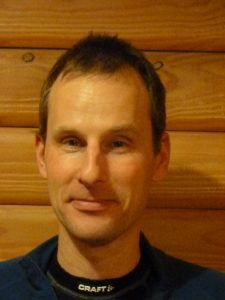
IVAN JONES, TEAM LEADER 2019 – PRESENT
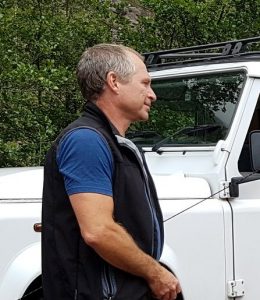
Mountain Rescue in Britain – the early days
A good history of the origins of mountain rescue has been written by Bob Sharp, Lomond MRT
